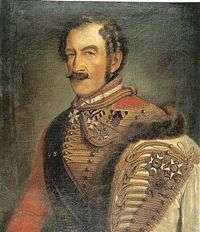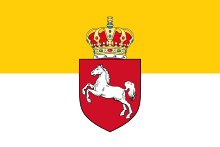Prince Ferdinand of Saxe-Coburg and Gotha
Prince Ferdinand of Saxe-Coburg and Gotha (Ferdinand Georg August; 28 March 1785 – 27 August 1851) was a German prince of the House of Saxe-Coburg and Gotha and a general of cavalry in the Austrian Imperial and Royal Army during the Napoleonic Wars. Despite remaining a Lutheran, by marriage he established the Catholic branch of the family, which eventually gained the thrones of Portugal (1837) and Bulgaria (1887).[1]:107
| Prince Ferdinand | |||||
|---|---|---|---|---|---|
| Prince of Saxe-Coburg and Gotha Duke of Saxony | |||||
 | |||||
| 1st Head of the House of Saxe-Coburg and Gotha-Koháry | |||||
| Tenure | 27 June 1826 – 27 August 1851 | ||||
| Successor | Prince August | ||||
| Born | 28 March 1785 Coburg | ||||
| Died | 27 August 1851 (aged 66) Vienna | ||||
| Burial | Mausoleum at Friedhof am Glockenberg, Coburg | ||||
| Spouse | Maria Antonia Koháry de Csábrág | ||||
| Issue | Ferdinand II of Portugal Prince August Victoria, Duchess of Nemours Prince Leopold | ||||
| |||||
| House | Wettin Saxe-Coburg and Gotha-Koháry (founder) | ||||
| Father | Francis, Duke of Saxe-Coburg-Saalfeld | ||||
| Mother | Countess Augusta Caroline Sophie Reuss-Ebersdorf | ||||
Birth and family
Ferdinand was born at Coburg as Prince Ferdinand of Saxe-Coburg-Saalfeld, the second son of Francis, Duke of Saxe-Coburg-Saalfeld and his second wife, Countess Augusta Caroline Sophie of Reuss-Ebersdorf. In 1826 his title changed from Prince of Saxe-Coburg-Saalfeld to Prince of Saxe-Coburg and Gotha, when his brother Duke Ernst I made a territorial exchange with other members of the family.
Ferdinand's nephews and nieces included Queen Victoria of the United Kingdom and her husband Prince Albert, as well as Empress Carlota of Mexico, and her brother King Leopold II of Belgium.
Military career
French Revolutionary Wars
On 10 December 1791 Ferdinand was commissioned as Unterleutnant in the Dragoon-Regiment Coburg Nr. 6. He was promoted to Oberleutnant on 1 March 1796 and to Second-Rittmeister on 18 November 1798.
Napoleonic Wars
On 1 February 1802 he transferred to the Austrian Army serving in the Chevauxleger-Regiment Fürst Rosenberg in which he was promoted to Major on 29 September 1804. On 1 January 1805 he transferred to the Husaren-Regiment Graf Blankenstein Nr. 6 in which he was promoted to Oberstleutnant on 6 August 1805.
War of the Fifth Coalition
On 15 September 1808 Ferdinand became Oberst in the Husaren-Regiment Erzherzog Ferdinand d'Este Nr. 3. It was in this regiment that he served in the War of the Fifth Coalition under Field Marshal Prince Hohenzollern. He received the knight's cross of the Military Order of Maria Theresa. Before the Battle of Wagram, he was named General of the Kavallerie Fürst Liechtenstein. On 15 April 1811 he was named Generalmajor.
War of the Sixth Coalition
During the War of the Sixth Coalition, Ferdinand fought at the battles of Kulm and Leipzig.
Concert of Europe
On 8 May 1822 Ferdinand became Inhaber (proprietor) of the Uhlanen-Regiment Fürst Karl Schwarzenberg. On 22 November 1828 he became Inhaber of the Husaren-Regiment Nr. 8. Shortly thereafter, he was promoted to the rank of General der Kavallerie.
Marriage and children
In Vienna on 30 November 1815, Ferdinand married Princess Maria Antonia Koháry de Csábrág et Szitnya, daughter and heiress of Ferenc József, Fürst Koháry de Csábrág et Szitnya, converting to Roman Catholicism in 1818.[2] When Antonia's father died in 1826, she inherited his estates in Hungary, and Ferdinand took the title of Duke of Saxe-Coburg and Gotha-Koháry.[3][4]
Ferdinand and Antonia had four children, all of whom were raised Catholic:
- Ferdinand II of Portugal (29 October 1816 – 15 December 1885), married Queen Maria II of Portugal on 9 April 1836. They had eleven children. He remarried Elisa Hensler on 10 June 1869.
- Prince August of Saxe-Coburg and Gotha (13 June 1818–26 July 1881), married Princess Clémentine of Orléans on 21 April 1843. They had five children.
- Princess Victoria of Saxe-Coburg and Gotha (14 February 1822–10 December 1857), married Louis, Duke of Nemours on 27 April 1840. They had four children.
- Prince Leopold of Saxe-Coburg and Gotha (31 January 1824–20 May 1884), married Constanze Geiger on 23 April 1861. They had one son.
Death
Ferdinand died at Vienna on 27 August 1851 at the age of 66. He is buried in the ducal mausoleum at Friedhof am Glockenberg in Coburg.[1]:47
Honours and awards
He received the following awards:[5]

- Knight of St. Andrew, 30 August 1808
- Knight of St. Alexander Nevsky, 30 August 1808
- Knight of St. George, 4th Class, 9 September 1813

.svg.png)

.svg.png)
.svg.png)
.svg.png)
.svg.png)
- Grand Cross of the Military Order of Christ, 9 December 1835
- Grand Cross of the Tower and Sword, 23 April 1836
.svg.png)

.svg.png)
.svg.png)
- Knight of the House Order of Fidelity, 1843
- Grand Cross of the Zähringer Lion, 1843
.svg.png)
Ancestry
| Ancestors of Prince Ferdinand of Saxe-Coburg and Gotha | |||||||||||||||||||||||||||||||||||||||||||||||||||||||||||||||||||||||||||||||||||||||||||||||||||||||||||||||||||||||||||||||||||||||||||||||||||||||||||||||||||||||||||||||||||||||||||||||||||||||||||||||||||||||||||||||||||||||||||||||||||||||||||||||||||||||||||||||||||||||||
|---|---|---|---|---|---|---|---|---|---|---|---|---|---|---|---|---|---|---|---|---|---|---|---|---|---|---|---|---|---|---|---|---|---|---|---|---|---|---|---|---|---|---|---|---|---|---|---|---|---|---|---|---|---|---|---|---|---|---|---|---|---|---|---|---|---|---|---|---|---|---|---|---|---|---|---|---|---|---|---|---|---|---|---|---|---|---|---|---|---|---|---|---|---|---|---|---|---|---|---|---|---|---|---|---|---|---|---|---|---|---|---|---|---|---|---|---|---|---|---|---|---|---|---|---|---|---|---|---|---|---|---|---|---|---|---|---|---|---|---|---|---|---|---|---|---|---|---|---|---|---|---|---|---|---|---|---|---|---|---|---|---|---|---|---|---|---|---|---|---|---|---|---|---|---|---|---|---|---|---|---|---|---|---|---|---|---|---|---|---|---|---|---|---|---|---|---|---|---|---|---|---|---|---|---|---|---|---|---|---|---|---|---|---|---|---|---|---|---|---|---|---|---|---|---|---|---|---|---|---|---|---|---|---|---|---|---|---|---|---|---|---|---|---|---|---|---|---|---|---|---|---|---|---|---|---|---|---|---|---|---|---|---|---|---|---|---|---|---|---|---|---|---|---|---|---|---|---|---|---|---|---|
| |||||||||||||||||||||||||||||||||||||||||||||||||||||||||||||||||||||||||||||||||||||||||||||||||||||||||||||||||||||||||||||||||||||||||||||||||||||||||||||||||||||||||||||||||||||||||||||||||||||||||||||||||||||||||||||||||||||||||||||||||||||||||||||||||||||||||||||||||||||||||
Bibliography
- Biographisches Lexikon des Kaisertums Österreich, II, 392-394.
References
- Klüglein, Norbert (1991). Coburg Stadt und Land (German). Verkehrsverein Coburg.
- Conversations-Lexikon der Gegenwart. F. Brockhaus. 1839.
- Militär-Schematismus des österreichischen Kaiserthums, Wien, k.k. Hof- und Staatsdruckerei 1840, S. 326
- Zeitung für den deutschen Adel, Band 1 (1840), S. 36, Vermählungen; Geburts- und Sterbefälle
- Adreß-Handbuch des Herzogthums Sachsen-Coburg und Gotha (1847). "Genealogie des Herzogliche Hauses", pp. 10-11
- Almanach de la cour: pour l'année ... 1817. l'Académie Imp. des Sciences. 1817. pp. 65, 83, 137.
- "Ritter-Orden: Militärischer Maria-Theresien-Orden", Hof- und Staatshandbuch des Kaiserthumes Österreich, 1814, p. 16, retrieved 6 November 2019
- "... Maria Theresien-Orden", Hof- und Staatshandbuch ... Österreich, 1816, p. 11, retrieved 6 November 2019
- "Königliche Ritter-orden". Staatshandbuch für den Freistaat Sachsen: 1850. Heinrich. 1850. p. 3.
- Hof- und Staats-Handbuch für das Königreich Hannover. Berenberg. 1849. p. 54.
- Adreß-Handbuch ... Sachsen-Coburg und Gotha (1847). "Herzogliche Sachsen-Ernestinischer Hausorden", p. 22
- Bragança, Jose Vicente de (2014). "Agraciamentos Portugueses Aos Príncipes da Casa Saxe-Coburgo-Gota" [Portuguese Honours awarded to Princes of the House of Saxe-Coburg and Gotha]. Pro Phalaris (in Portuguese). 9–10: 6–7. Retrieved 28 November 2019.
- Almanach royal officiel, publié, exécution d'un arrête du roi, Volume 1: Tarlier, 1854, p. 37
- Shaw, Wm. A. (1906) The Knights of England, I, London, p. 188
- M. & B. Wattel (2009). Les Grand'Croix de la Légion d'honneur de 1805 à nos jours. Titulaires français et étrangers. Paris: Archives & Culture. p. 523. ISBN 978-2-35077-135-9.
- Hof- und Staats-Handbuch des Großherzogtum Baden (1850), "Großherzogliche Orden" pp. 33, 48